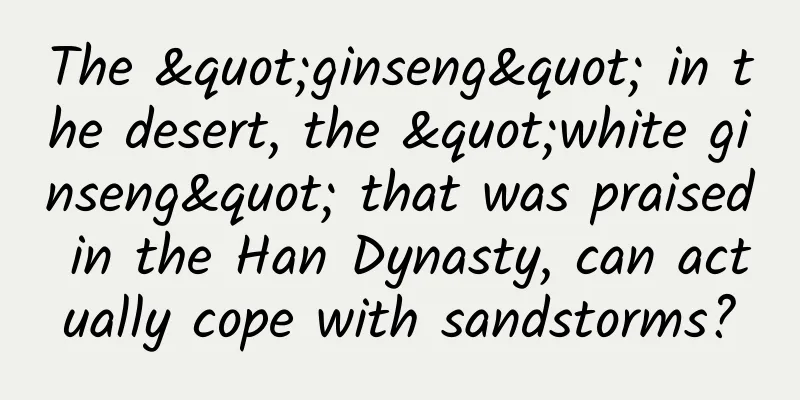The "ginseng" in the desert, the "white ginseng" that was praised in the Han Dynasty, can actually cope with sandstorms?

|
Cistanche deserticola, also known as Cistanche deserticola, commonly known as Dayun, also known as "desert ginseng", is a perennial parasitic herb of the Orobanchaceae family. The underground stem of Cistanche deserticola is fleshy, cylindrical, often unbranched, and the leaves are scale-like and arranged spirally on the stem. The spike inflorescence is terminal at the stem end, with many flowers, the calyx is tubular or bell-shaped, the corolla tube is pale yellowish white, and the flowering period is from May to June. The "Shennong Bencao Jing" of the Han Dynasty listed it as a top-grade medicine, and it has been recorded in herbal books of all dynasties and is highly praised. Cistanche deserticola is widely distributed in my country, from the Songliao Plain in the northeast to the Inner Mongolia grasslands and the vast desert areas in western China, with a distribution area of more than 360 square kilometers. In my country, there are 8 species of Cistanche deserticola, including Cistanche deserticola, Cistanche tubulosa, Cistanche fasciata, Cistanche lanzhouensis, Cistanche deserticola, Cistanche ningxiaensis, and Cistanche schizophylla. The two species recorded in medical books of all dynasties and first included in the Pharmacopoeia of the People's Republic of China are Cistanche deserticola and Cistanche salt. In 2004, Cistanche tubulosa was also included in the Pharmacopoeia. Farmers in Qiemo County, Xinjiang, are digging up artificially grown Cistanche deserticola Cistanche mainly parasitizes on the roots of drought-tolerant plants in sandy areas such as tamarisk and tamarisk. As a parasitic plant, the trees and shrubs such as tamarisk and tamarisk that Cistanche parasitize have strong wind-proof and sand-fixing capabilities, and have greatly improved the ecological environment. Located on the southern edge of the Taklimakan Desert, two-thirds of the area of Qiemo County is desertified land. Over the years, Qiemo County has actively developed the inoculation of Cistanche under the Haloxylon ammodendron forest in the practice of sand prevention and control. At present, the total area of windbreak and sand control forests in the county is about 170,000 mu, and the inoculation area of Cistanche under the Haloxylon ammodendron forest is about 80,000 mu. The average annual number of days of local sandstorm weather has dropped from about 16 days in the 1980s to 11 days in recent years, and the average annual number of days of floating dust weather has dropped from 128 days to 98 days in recent years. The Cistanche deserticola industry not only makes the desert green, but also achieves a "win-win" situation of ecological, economic and social benefits. In recent years, the artificial high-yield cultivation of Cistanche deserticola in red willow and Haloxylon ammodendron forests has been successful. The yield of Cistanche deserticola per mu can reach more than 500 kilograms, and the annual income per mu is more than 3,000 yuan. Through the development of this industry, the 6,000 square kilometers of desert in the main production area of Cistanche deserticola has been transformed into an oasis, building a solid ecological barrier. Experts predict that by 2026, this industry that makes the desert "gold" is expected to exceed 50 billion yuan in scale, and has great potential for long-term development. At present, more than 3 million mu of Cistanche deserticola have been planted in Xinjiang, Inner Mongolia, Gansu and other provinces and regions, and the annual output of Cistanche deserticola medicinal materials has reached 8,500 tons. The Cistanche deserticola industry has blossomed everywhere, completely solving the problem of shortage of Cistanche deserticola medicinal resources. In addition, in-depth research has been conducted on the development of new Cistanche deserticola products. At present, a number of new products have been developed, including health wine, Cistanche deserticola slices, and active ingredient extract capsules. Continuing to utilize these plants that have strong salt and drought resistance and have high economic value and development potential, and establishing a scientific and efficient ecological planting model that takes into account both economic and ecological benefits, is the direction and driving force for future efforts. Review expert: Yang Rurong, associate researcher at the Institute of Geography and Natural Resources Research, Chinese Academy of Sciences China Association for Science and Technology Department of Science Popularization Xinhuanet Co-production |
<<: I often forget things. Does this mean I have Alzheimer's?
>>: Mianyang: Sichuan’s toughness, China’s confidence
Recommend
Google merges Android Pay and Google Wallet into new "Google Pay" brand
[[216522]] Tencent Technology News: In the mobile...
Longer term trends of the top 10 programming languages ranking (1989-2014)
IOBE has just released the November programming l...
What is on the list of lockdown areas in Pudong, Shanghai in 2022? When will the blockade be lifted? Attached are the latest regulations!
Based on preliminary screening results and risk a...
How to quickly increase your store sales from 0 to 3,000
1. Background Store promotion will start on Novem...
[Case] How does an e-commerce app develop an operation and promotion strategy from scratch?
Through this article, you can learn how to formul...
Link Motion Announces Strategic Investment from China AI Capital Limited and Board Adjustment
Beijing, July 19, 2018 – Link Mobility Ltd. (NYSE...
ViewController has many good transition animations
Source code introduction Cool transition animatio...
Improve product conversion rate and manage "user value" well
If you want to increase product sales, conversion...
After nearly 20 years, the all-new BMW 8 Series will debut tomorrow night
The new generation BMW 8 Series will make its glo...
What is China's national flower? Do the red beans in red bean smoothie represent lovesickness? Let's take a look at the secrets of plants
What is China's national flower? Do the red b...
What kind of flowers did Chang Yu want?
Yesterday, Jay Chou's new song "The Grea...
Urgent reminder! The venom is as strong as sulfuric acid, don't take pictures!
What should you do if a mosquito lands on you? Ma...
The secret to increasing followers through short video promotion!
How long has it been since you finished reading a...
Are you one of these 730,000 car owners? Guangqi Honda's sales in 2017 exceeded 730,000
According to official information from GAC Honda,...
Can homosexuals have children? ——Research results of new academicians
Dear friends, do you feel that the Internet has b...


![[Creative Cultivation Program] The mystery of the origin of mitochondria: How was the energy factory of eukaryotic cells built?](/upload/images/67f25b3c53b12.webp)






